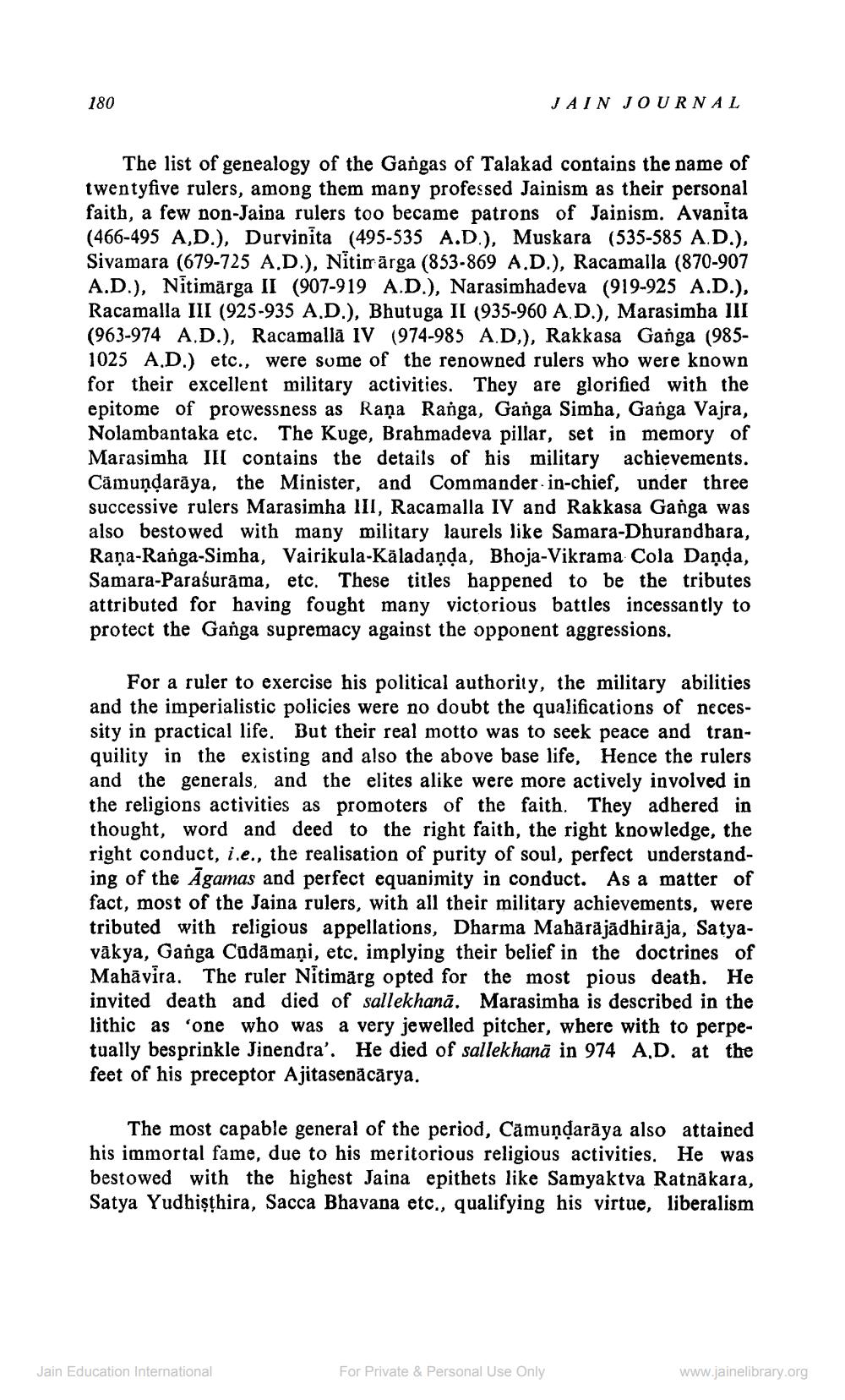________________
180
JAIN JOURNAL
The list of genealogy of the Gangas of Talakad contains the name of twentyfive rulers, among them many professed Jainism as their personal faith, a few non-Jaipa rulers too became patrons of Jainism. Avanita (466-495 A,D.), Durvinita (495-535 A.D.), Muskara (535-585 AD.), Sivamara (679-725 A.D.), Nitimārga (853-869 A.D.), Racamalla (870-907 A.D.), Nitimārga II (907-919 A.D.), Narasimhadeva (919-925 A.D.), Racamalla III (925-935 A.D.), Bhutuga II (935-960 A.D.), Marasimha III (963-974 A.D.), Racamallă IV (974-985 AD,), Rakkasa Ganga (9851025 A.D.) etc., were some of the renowned rulers who were known for their excellent military activities. They are glorified with the epitome of prowessness as Raņa Ranga, Ganga Simha, Ganga Vajra, Nolambantaka etc. The Kuge, Brahmadeva pillar, set in memory of Marasimha II contains the details of his military achievements. Cămundarāya, the Minister, and Commander-in-chief, under three successive rulers Marasimha III, Racamalla IV and Rakkasa Ganga was also bestowed with many military laurels like Samara-Dhurandbara, Raņa-Ranga-Simha, Vairikula-Käladaņda, Bhoja-Vikrama Cola Danda, Samara-Paraśurāma, etc. These titles happened to be the tributes attributed for having fought many victorious battles incessantly to protect the Ganga supremacy against the opponent aggressions.
For a ruler to exercise his political authority, the military abilities and the imperialistic policies were no doubt the qualifications of necessity in practical life. But their real motto was to seek peace and tranquility in the existing and also the above base life. Hence the rulers and the generals, and the elites alike were more actively involved in the religions activities as promoters of the faith. They adhered in thought, word and deed to the right faith, the right knowledge, the right conduct, i.e., the realisation of purity of soul, perfect understanding of the Agamas and perfect equanimity in conduct. As a matter of fact, most of the Jaina rulers, with all their military achievements, were tributed with religious appellations, Dharma Mabărājādhirāja, Satyavākya. Ganga Cudamani, etc, implying their belief in the doctrines of Mahāvira. The ruler Nitimārg opted for the most pious death. He invited death and died of sallekhanā. Marasimha is described in the lithic as 'one who was a very jewelled pitcher, where with to perpetually besprinkle Jinendra'. He died of sallekhanā in 974 A.D. at the feet of his preceptor Ajitasenācārya.
The most capable general of the period, Cămundarāya also attained his immortal fame, due to his meritorious religious activities. He was bestowed with the highest Jaina epithets like Samyaktva Ratnakara, Satya Yudhisthira, Sacca Bhavana etc., qualifying his virtue, liberalism
Jain Education International
For Private & Personal Use Only
www.jainelibrary.org




